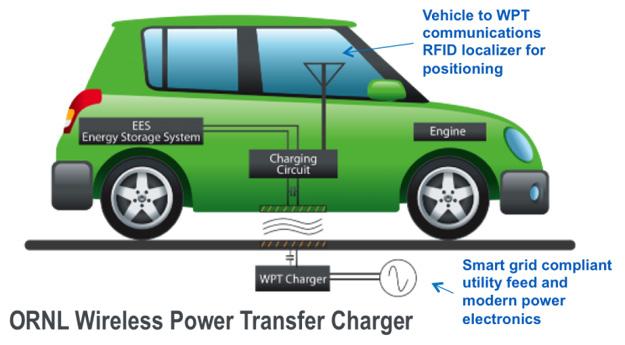
It looks like the United States government is declaring a war on wires – sort of. Recently, The United States Department of Energy (DOE) has announced it will contribute up to $4 million to help develop wireless chargers for electric vehicles (EVs).
The DOE will seek to award as many as four innovative projects that show promise in the field of wireless charging systems. Projects awarded federal funding will be announced by summer of 2012 by the Office of Energy Efficiency and Renewable Energy Vehicle Technologies Program (which ironically might be the least efficient name ever).
For those that may be unfamiliar with wireless charging, it’s pretty much exactly what it sounds like: Instead of using a wire (or cable, as the case is with EVs), EV owners would simply drive to a designated charging area and your car would begin to charge sans wires — assuming it was outfitted with the proper equipment of course.
Research is even currently underway that could allow EVs to charge while on the go, greatly extending range, and possibly bypassing the need for larger batteries altogether. Stanford University is doing some very interesting work in this particular field by utilizing magnetic fields that could wirelessly charge your moving car.
Of course, as it stands now, more than a few stumbling blocks remain preventing a large acceptance of electric cars. Chief among them are concerns over inconvenient charging times, adequate charging infrastructure, and unrefined battery technology.

Advocates of electric vehicles believe that wireless charging – along with a concerted effort to promote and utilize lighter and smaller battery packs – has the potential to combat those concerns, and encourage a widespread adoption of EVs by making them much more convenient to charge.
Along with the growing electric car market, revenue from charging stations is expected to increase by a substantial amount with more and more people purchasing electric cars. As people continue to seek alternative means to power their vehicles, electricity – at least for now – is the next step in the evolution of the modern automobile.
While some argue the need for a more efficient experience, others think that battery technology and cost needs to be addressed first. Unfortunately, lithium-ion battery cost has remained relatively stagnant with little to no decrease in manufacturing costs, preventing EVs from being affordable to most consumers. While there are those within the automotive industry that predict prices will indeed drop soon, others have disagreed, arguing that it will likely take well into 2020 to see a significant decrease in cost.
Because government-funded anything rarely fails to rally those from both side of the political line, some will undoubtedly view the DOE’s wireless charging funds as nothing more than a waste of taxpayer’s money — or the next Solyndra — while others will see it as an appropriate step for the government.
Regardless, it looks like the DOE will continue to earmark funds for various research efforts, and in the long term promote higher emissions standards for the automotive industry, and hopefully a much more convenient and efficient way of charging your electric car.


